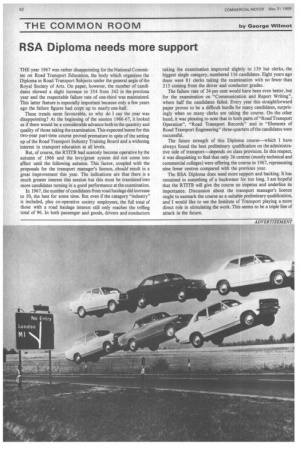RSA Diploma needs more support
Page 64

If you've noticed an error in this article please click here to report it so we can fix it.
THE year 1967 was rather disappointing for the National Committee on Road Transport Education, the body which organizes the Diploma in Road Transport Subjects under the general aegis of the Royal Society of Arts. On paper, however, the number of candidates showed a slight increase to 354 from 342 in the previous year and the respectable failure rate of one-third was maintained. This latter feature is especially important because only a few years ago the failure figures had crept up to nearly one-half.
These trends seem favourable, so why do I say the year was disappointing? At the beginning of the session 1966-67, it looked as if there would be a considerable advance both in the quantity and quality of those taking the examination. This expected boom for this two-year part-time course proved premature in spite of the setting up of the Road Transport Industry Training Board and a widening interest in transport education at all levels.
But, of course, the RTITB had scarcely become operative by the autumn of 1966 and the levy/grant system did not come into cffect until the following autumn. This factor, coupled with the proposals for the transport manager's licence, should result in a great improvement this year. The indications are that there is a much greater interest this session but this must be translated into more candidates turning in a good performance at the examination.
In 1967, the number of candidates from road haulage did increase to 50, the best for some time. But even if the category "industry" is included, plus co-operative society employees, the full total of those with a road haulage interest still only reaches the trifling total of 96. In both passenger and goods, drivers and conductors taking the examination improved slightly to 139 but clerks, the biggest single category, numbered 116 candidates. Eight years ago there were 81 clerks taking the examination with no fewer than 213 coming from the driver and conductor grades.
The failure rate of 34 per cent would have been even better, but for the examination on "Communication and Report Writing", where half the candidates failed. Every year this straightforward paper proves to be a difficult hurdle for many candidates, surprisingly when so many clerks are taking the course. On the other hand, it was pleasing to note that in both parts of "Road Transport Operation", "Road Transport Records" and in "Elements of Road Transport Engineering" three-quarters of the candidates were successful.
The future strength of this Diploma course—which I have always found the best preliminary qualification on the administrative side of transport—depends on class provision. In this respect, it was disquieting to find that only 36 centres (mostly technical and commercial colleges) were offering the course in 1967, representing nine fewer centres compared with the previous year.
The RSA Diploma does need more support and backing. It has remained in something of a backwater for too long. I am hopeful that the RTITB will give the course an impetus and underline its importance. Discussion about the transport manager's licence ought to earmark the course as a suitable preliminary qualification, and I would like to see the Institute of Transport playing a more direct role in stimulating the work. This seems to be a triple line of attack in the future.








































































































